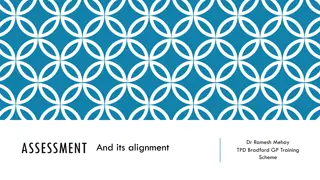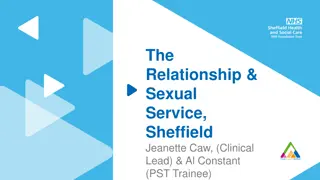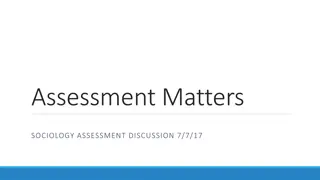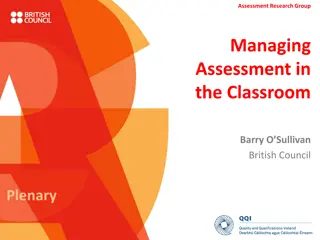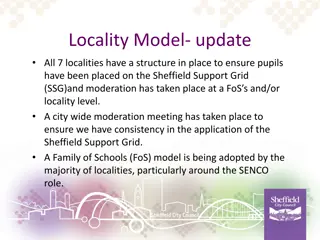Sheffield Education Assessment Update 2016
Sheffield's education assessment update for 2016 shows improvements in Foundation Stage development levels and a slight decrease in Phonics decoding standards compared to the national average. Key Stage 1 saw a drop in pupils meeting expected standards, with gaps in reading, writing, and maths compared to the national level. Key Stage 2 introduced a new assessment framework with scaled scores in reading, maths, and GPS. Sheffield narrowed the gap in achieving expected standards with the national average.
Download Presentation

Please find below an Image/Link to download the presentation.
The content on the website is provided AS IS for your information and personal use only. It may not be sold, licensed, or shared on other websites without obtaining consent from the author.If you encounter any issues during the download, it is possible that the publisher has removed the file from their server.
You are allowed to download the files provided on this website for personal or commercial use, subject to the condition that they are used lawfully. All files are the property of their respective owners.
The content on the website is provided AS IS for your information and personal use only. It may not be sold, licensed, or shared on other websites without obtaining consent from the author.
E N D
Presentation Transcript
2016 Primary Assessment Update 27th September 2016
2016 Headlines Foundation Stage 69% of children in Sheffield achieved a good level of development at the end of the Foundation Stage. This is equivalent to the provisional national result. Provisional data indicates that the achievement gap has closed by 4% points to 31.7%. All localities showing an upwards trend over the last 4 years.
2016 Headlines Phonics 77% of children in Sheffield achieved the required standard of phonics decoding. This is 4% points below the national average of 81%. The gap between Sheffield and national has remained the same at 4% points. All localities showing an upwards trend over the last 4 years.
2016 Headlines Key Stage 1 New assessment framework this year. % of pupils working at or above the expected standard has dropped in Sheffield and nationally compared to % at level 2b+ in previous years. % of pupils working at or above expected standard in Sheffield is: 71% (reading); 65% (writing); 71% (maths). Gaps with national are: 3% (reading); 1% (writing); 2% (maths). Compared to last year the gaps have increased in reading and maths (by 1% point) and narrowed in writing (by 1% point). EXS working at the expected standard GDS working at greater depth within the expected standard
Key Stage 1 subject comparison, % EXS in reading, writing and maths
2016 Headlines Key Stage 2 New assessment framework pupils working at the level of test in reading, maths and GPS have received a scaled score between 80 and 120. Pupils working at a higher standard are those achieving a scaled score of 110 or higher in reading and maths or working at greater depth in writing. The new expected standard is estimated to be roughly equivalent to a level 4a in reading and between a 4b and 4a in maths. Progress will calculated using the difference between the KS2 scaled score and the KS1 average points score. BUT there is no individual level progress target for pupils. Schools will be below floor if: fewer than 65% of pupils reach the expected standard in ALL of reading, writing and maths AND the school is below the floor standard for ANY of the individual progress measures in reading (-5), writing (-7) or maths (-5). NB confidence intervals will be applied to the progress measures similar to the method used to show significant greens and blues in RAISE.
2016 Headlines Key Stage 2 Significant difference in the % achieving the expected standard in reading, writing and maths 52% compared to level 4+ (78% in 2015) Sheffield has closed the gap and is only 1% point below national average (53%) 5% of pupils achieved the higher standard or greater depth in all three subjects, equivalent to the national average) For individual subjects the largest gap is for reading Sheffield 62% compared to a national average of 66% EXS working at the expected standard GDS working at the higher standard / greater depth
2016 Headlines Key Stage 2 EXS working at the expected standard, GDS working at the higher standard / greater depth, average scaled score is only available for pupils who sat the tests i.e. were not working below the standard of the tests
Key Stage 2 subject breakdown Reading tended to be the limiting factor that prevented pupils achieving the combined measure. Only 2% achieved the expected standard in reading only. 78% of pupils achieved the expected standard in at least one of 3 subjects. 17% achieved the expected standard in writing but not in reading. 6% of pupils scored 98 or 99 points in reading (i.e. just missed the threshold).
Key Stage 2 subject comparison, % EXS in reading, writing, maths & GPS
How does Sheffields performance compare to other LAs? National rankings give an indication of how Sheffield s performance compares to other local authorities provisional data shows Sheffield ranks 92 out of 150 LAs (1 is best performance) on the combined measure, this is an improvement compared to the 2015 rank of 116. Sheffield deprivation ranking is 105. Subject National rank 2013 National rank 2014 National rank 2015 National rank 2016 (provisional) Combined RWM 123 117 116 92 Reading 139 143 142 119 Writing 131 122 126 77 Maths 129 115 103 99 GPS 141 106 117 104 National ranks have improved across all measures but reading is still the weakest performing subject relative to other LAs
KS2 - Progress calculation Provisional progress data was made available to schools on 1st September New progress measures are value-added and measure the distance travelled between Key Stage 1 and Key Stage 2. Steps in working out progress.... 2. Each pupil is assigned to a prior attainment group based on their KS1 average points 1. Calculate KS1 average points score average of reading and writing combined with maths A progress score of 0... means the pupil has achieved the level of KS2 attainment expected given their KS1 score A progress score above 0... means the pupil has achieved a higher level of KS2 attainment than predicted from their KS1 score A progress score below 0... means the pupil has achieved a lower level of KS2 attainment than predicted from their KS1 score 3. The DfE have calculated the average score for each subject for each prior attainment group. Where a pupil does not have a scaled score (e.g. in writing or if they are working below the test) they are assigned a score based on their teacher assessment. 4. Compare the pupils actual KS2 score with the expected score the difference is the pupil s progress score. The school progress score is an average of the individual pupil scores
KS2 - Progress statistical significance and floor standards A school s overall progress scores show on average whether pupils make more or less progress compared to pupils with similar prior attainment nationally. A significance test will be applied to the progress scores to determine if they are significantly different from 0. 0 represents national average progress. If the school s progress score is below -5 in reading or maths or below -7 in writing AND the school has achieved less than 65% then the school is below the floor standard* *providing a sufficient number of pupils have progress results
KS2 - Progress results Overall progress scores for Sheffield are above average for writing, close to 0 for maths and below 0 for reading. blue = significantly below 0, green = significantly above 0, grey = not significant
KS2 - Progress distribution of scores 20 Sheffield 15 National number of schools 10 5 0 -10 -5 0 5 10 reading progress score 25 20 Sheffield Sheffield 20 15 number of schools number of schools 15 10 10 5 5 0 0 -10 -5 0 5 10 -10 -5 0 5 10 maths progress score writing progress score
Pupil groups Group discussion on progress analysis by pupil groups.....
RAISEonline Available late October dates not yet released New thresholds, expected standard and greater depth / higher standard Average scaled scores New progress measures Summary shows breakdown for low, middle, high prior attainment for all pupils and disadvantaged pupils. Disadvantaged pupils are compared against non- disadvantaged pupils nationally. Statistical significance is applied as before AND there will be additional shading to indicate top / bottom 10% Example progress report
RAISEonline Pupil group comparisons fall into 3 types: comparison against the same group (for example gender, EAL, non SEN) comparison against non-disadvantaged group (disadvantaged, CLA, FSM) comparison against all pupils (SEN)
Other key releases Inspection dashboard to be used for inspection preparation, likely to be released after RAISE, content not yet announced Primary Performance Tables 15th December Floor standards provisional data already includes progress and the thresholds have been announced but will not be confirmed until Performance Tables Coasting schools.....
KS2 - Coasting Schools The DfE plans to inform schools if they meet the coasting definition after the 2016 Performance Tables are published in December. These schools will need to demonstrate that they have sufficient capacity to improve or face further action. Schools will be identified as coasting using data from 2014, 2015 and 2016. In 2014 and 2015 a school is coasting if fewer than 85 per cent of pupils achieve Level 4+ in reading, writing and mathematics and the percentage of pupils making expected progress in reading, writing and maths are all below the national medians. In 2016 a school is coasting if fewer than 85 per cent of pupils achieve the new expected standard across reading, writing and mathematics and pupil progress is below the threshold in any one of reading, writing or maths. The progress measure for coasting will be calculated in the same way as the progress floor standards but the coasting standard will be set at a higher level than the progress floor standard. A school is only classified as coasting if it meets these criteria in ALL 3 years School identified as coasting after the 2016 accountability data is published will be notified and will become eligible for intervention. However, they will not automatically be subject to intervention .
Primary Categorisation Each locality has a process for carrying out the categorisation: o School Information Forms are completed. o School & Locality data is available. o Locality & Learn Sheffield categorise each school and feed back (where necessary) by Friday 14th October. o Learn Sheffield writes to all schools on Monday 17th October. o School Profiles will be shared once complete but this will not delay the process. We have agreed that we will write to all schools at the same time, even if that leads to a delay for some localities. The letters will be accompanied by a Guide to Categorisation and some accompanying documents everything goes to the Headteacher (or equivalent) & Chair of Governors (or equivalent). The process is about the effective targeting of resources and is based on the principle that each school has an entitlement.
Achievement Strategy The strategy includes the activity that will support all schools in preparation for Statutory Tests in 2017: o Moderation city, locality & school level o Tracking using predictions to inform support for schools o Briefings school leaders & FS2/Y2/Y6 teachers o Support & Guidance (including Access Arrangements) The team working on this are LSIPs and Associate LSIPs the discussion and decisions will be taken at the Primary Improvement Board in October. The strategy also includes school improvement activity (school self evaluation, school improvement planning, support with data analysis, Ofsted preparation, etc.) which will be offered to schools as part of the support and challenge entitlement following categorisation.
Locality Action Plans Each locality will develop a School Improvement Action Plan to capture the school improvement activity there is flexibility about when, how, etc. The content will be based upon the agreement between Learn Sheffield and each locality. The categorisation process may lead to some additional or different activity. The development of the locality data picture may lead to some additional or different activity. The achievement strategy may lead to some additional or different activity. The plan needs to be a working document and, most importantly, needs to support the work of the locality. Each locality can decide how to approach this additional information.





